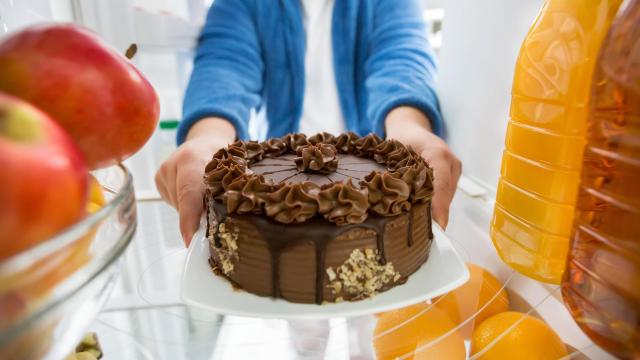Fruit is refreshing when served cold. Yogurt is at its most delightful, creamy state when chilled. Ice? Transcendent. But cake: That is where I have to stop you. For the love of all saturated fats, and everything good, please stop eating cold cake.
There are exceptions to this, of course. Ice cream cakes, custard fillings, and whipped creams have legitimate business with the chill chest. Specifically, this concerns butter-based cakes and frostings. Those benefit from being left at room temperature before serving. It’s not because it slices better (it doesn’t), or because it looks better (appearances are the same), but because it tastes better. I’m saying this as a distant food-friend, but also as a professional cake decorator: Taste is priority number one, and cold saturated fat doesn’t taste like anything. If your cake batter has butter as the primary fat, and, likewise, the frosting is buttercream, you’re robbing your tastebuds with every frigid bite.
Try it: This is an experiment, not a dare. Go slice a bit of fridge-cold butter off the stick, and eat it. Take a bit of softened butter and do the same. You can feel the texture difference, and how the softened butter coats more of your tongue. (I guess you can do this on your fingertips but what fun is that?) Cold saturated fats are waxy, and the globules are cold and stuck to each other. When they surf around in your mouth, only the outer layer of fats will melt at body temperature and get a chance to cling to your taste buds and deliver flavour. The rest will go straight past to continue their journey. That goes for the rest of the flavours mixed into the cake and frosting too. The flavours of chocolate, almond, and salted caramel are all Han Solo in the butter-carbonite of your cake. When the entire bite is warm, the flexible, softened fat globules get a chance to melt, coat your whole mouth, and reveal the cake’s flavours. It’s the same reason you should be serving your expensive cheeses at room temperature too.
The second issue is the dry texture of cold cake, which I find gritty and unpleasant. Although it’s a different result, the cause is the same: Cold saturated fat is hard. A cold, butter-based cake reads as dry in your mouth. It’s ideal to cut, split, or shape when you decorate the cake, but not for eating. A room temperature, or slightly warm cake, is spongy, soft, and tender. (If you eat an oil-based cake, you’ll notice this doesn’t happen because the oils stay flexible when cold.)
Eating cold cake leads to a waxy, dry, flavour-deprived experience. Cake creators want you to enjoy the cake at its peak flavour and texture. Leave it at room temperature. Most butter cakes and buttercreams keep perfectly well on the counter for five days, easy. Store the cake, well-covered, on the counter for easy access (and as a bonus, seeing it constantly keeps you from forgetting you have cake). If you must store it in the fridge, bring the cake out to sit on the counter at least an hour or two before digging in.

Leave a Reply
You must be logged in to post a comment.